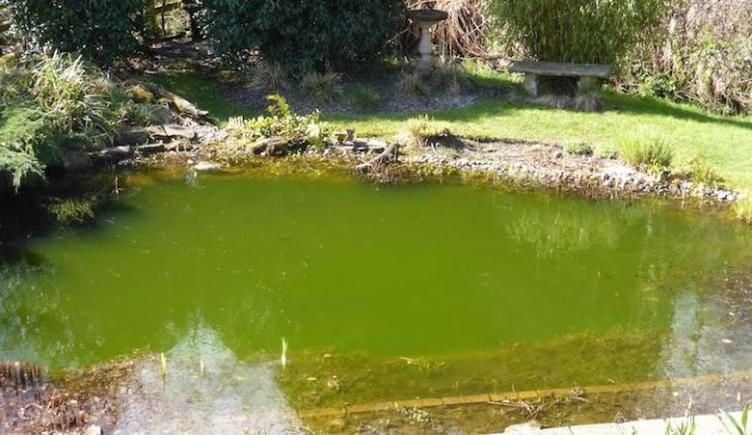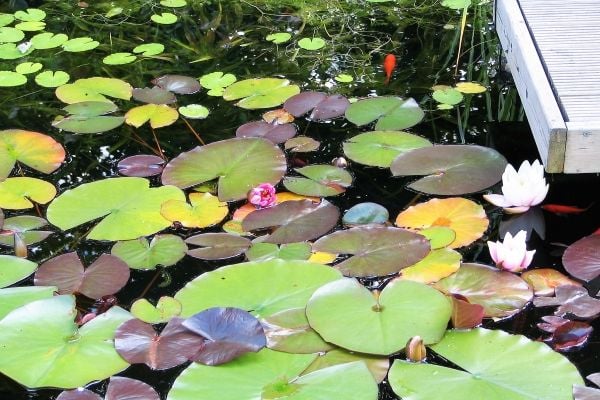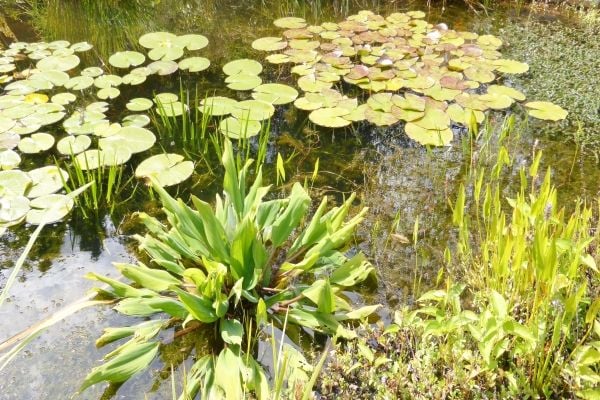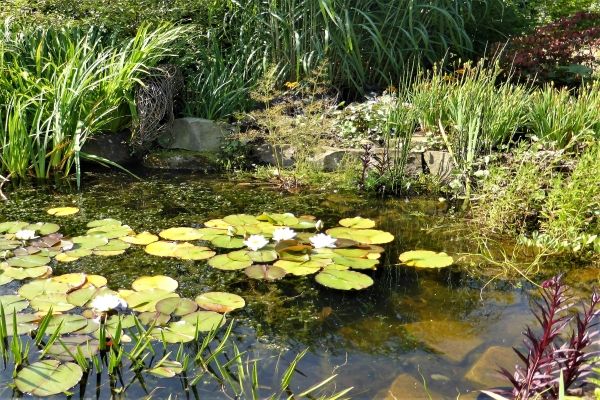What to do about a green pond and how to clear it

What to do about a green pond
A pond will attract a variety of wildlife into the garden such as frogs, damselflies, dragonflies, water boatman and pond skaters. Many types of birds will visit for a bath and a dip; I even had a kingfisher dive in for a fish.
But what should you do if your pond looks like a bowl of pea soup? The good news is that this can be fixed. Here’s how.
Getting A Natural Water Balance
The cause of greening is algae. Usually a pond is fairly clear over winter, and in spring the ecology of the pond changes. The temperature and sunlight levels increase, the pond water warms up and it turns green. To live in your pond, algae like sun, minerals and nutrients to feed on. The key to maintaining a pond with clear water is to have an ecological balance, which reduces these elements, which will inhibit the algae.
Reduce sunlight to the pond
Cutting down the amount of sun into the pond will make the conditions less suitable for the algae. This may seem counter intuitive since most pond plants like a good amount of sun. Essential, to keep the pond clear you need keep algae in check. The way to do this is to cover a good part of the pond’s surface with plants so that the water underneath is shaded. Lots of pond plants, submerged plants and water lilies are ideal. You should aim to cover about half of the pond’s surface with plants.

Why is my pond green?
Reduce nutrients in the pond
Algae feed on the nutrients in the pond. Reducing the nutrients in the water will inhibit algae growth. Avoid constructing a pond near deciduous trees and shrubs. When leaves fall into a pond, they sink to the bottom, rot down and make the water more nutrient rich. In addition, they also release toxins which pollute the water and endanger pond life. If leaves fall into the pond, it is best to skim them off with a net and remove.
Also, it may be tempting to use ordinary compost when planting into a pond, but it is full of nutrients. It is better when adding plants to the pond to use sterile aquatic compost. This type of compost is free from peat and nutrients and will reduce the nutrients entering the pond water. There is also the thorny issue of fish, and whether to introduce fish into the pond. Fish are attractive, but they excrete, which adds nutrients to the pond and feeds the algae.
Oxygenate the water
Algae grow fast and can rapidly deplete the water of oxygen. It is important to oxygenate the water to support plants and wildlife, which helps keep the water clear. Submerged oxygenating plants are invaluable to the natural balance of the pond. These are plants such as rancorous aquatilis (water crowfoot) , hottonia palusrris (water violet), potamogeton cripus (curled pondweed), and myriophyllum verticllatum (milfoil) . They will also help the algae-eating animals, such as water snails and tadpoles. Most oxygenating plants grow well, but depending on your local conditions, you may have to try several to establish which grows best. Most are easy to control so they do not get out of hand. Some oxygenating plants are invasive, such as parrots feather, which once planted have the potential to escape and overwhelm native plants.
A fountain or a waterfall makes a lovely water feature. It both looks good and serves the practical purpose of adding more oxygen to the water. (If planting water lilies, note that they don't like being splashed.) Installing a waterfall/fountain will require a pump which can be combined with a filter and an uv clarifier, which also helps to keep the water clearer.
In the image below, much of the surface is covered by lily pads and next to the lily pads in top right are the oxygenating plants Elodea crispa, and below right Ceretophyllum demersum, Hornwort.
Also illustrated, the large plant in the centre is Orontium aquatiucum , common name Golden club, and the right is Pontederia cordata, common name pickerelweed or pickerel weed.

Further ways to reduce algae
The size of a pond can affect its natural balance. A larger pond will maintain its natural balance easier than a smaller one. A small, shallow, under planted pond will heat up faster and suffer more from algae bloom.
I have found Barley straw effective, although it doesn’t seem to work for everyone. The straw decomposes in the water, inhibiting the growth of algae.
A pond filter can be very helpful in removing algae. If you intend to have any significant number of fish, a filter is essential to maintain good quality water for the fish and to ensure that the fish excreta doesn’t feed the algae. It is important to buy the right size of filter for the size and depth of the pond, which is determined by volume of water, and number of fish to be stocked in the pond. Specialist suppliers are happy to offer advice on this.
There are chemicals which can be added, but I am not happy to add them to a pond which is full of wildlife. It is a matter of personal choice.
The sustainable way forward is to build up the ecological balance in the pond so that it naturally takes away the algae. It is part of the pond cycle that early in the season there will be an algae bloom, when the water first warms up. Then the oxygenating plants start to work, the vegetation grows, and the lily pads will spread over the pond surface. Within a week or two, the green bloom fades and the water becomes clear. The period of green should be limited to a couple of weeks early in the season. This way, it is possible to have algae free pond for many years. Apart from the early spring bloom, algae is not inevitable in a pond.
See also:-A step-by-step guide how to build a garden pond; how to instal a Butyl liner, wildlife and garden ponds and garden pond ideas.

